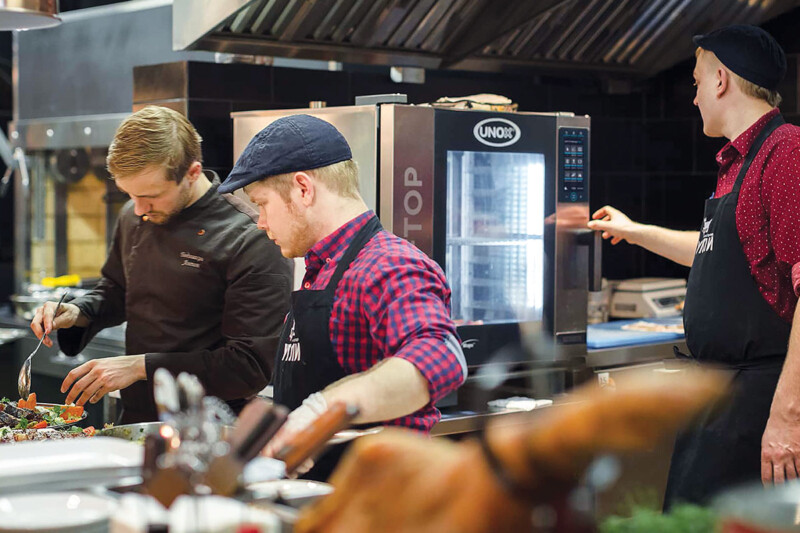Unpacking Combis’ Ever-Flexible Innovations
Skill-adjacent controller options, new ventless hoods and cleaning system updates mark a few recent updates in the bustling category.
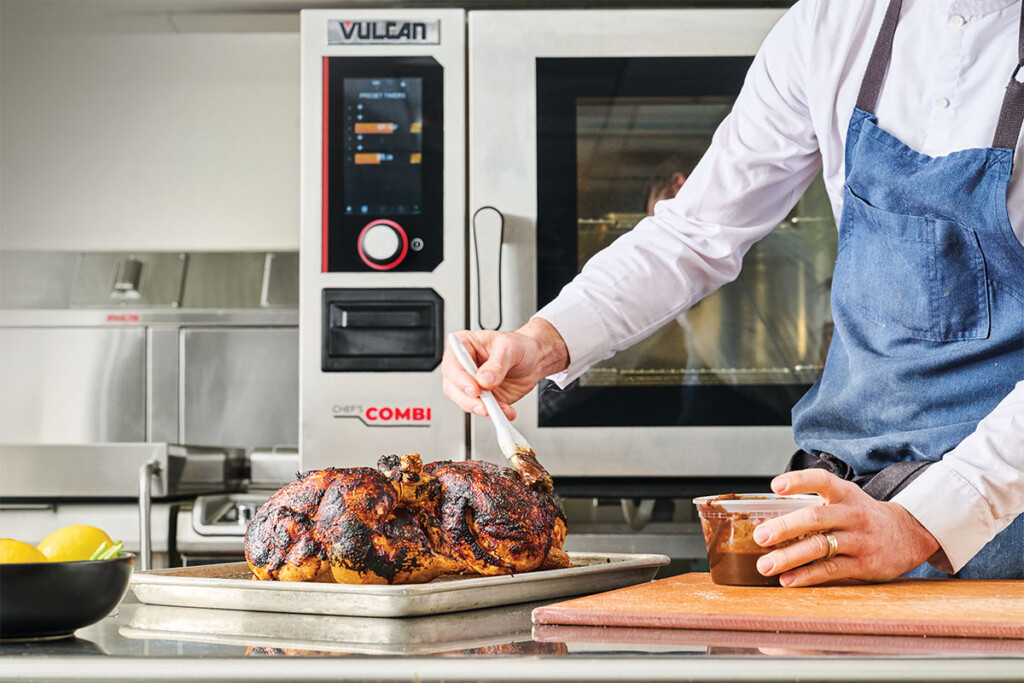
Complex simplicity may sound contradictory, but with combis, the pairing rings true.
Some of the newest models step up programmability, connectivity and other technology to aid in cooking and cleaning, with touch screen setups that mimic cellphones for ease of use.
“Everyone seems to be competing on automation, connectivity and flexibility, all surrounded by cooking performance,” says one maker. “All the combis can roast, steam, grill (and more); that’s what we’re all designed to do, but what sets us apart is the ecosystem around the oven.”
Additional compact models—including a mini combi with AI-driven optical cooking—as well as new ventless models also have hit the market, adding functional flexibility.
Bundle this with the fact that a combi can replace select hot-side equipment, depending on volume and space, and it’s difficult to imagine an operator who couldn’t put a combi to work.
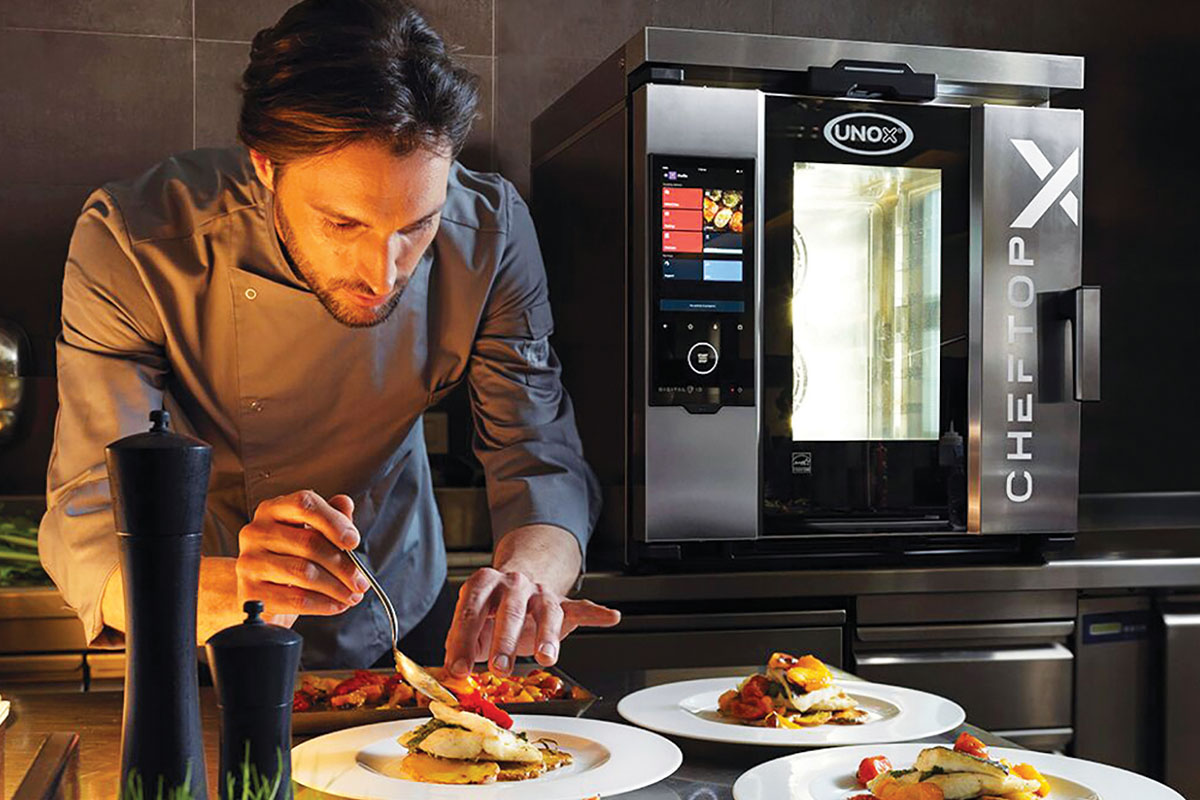
Select models offer an optic cooking option that activates cooking settings for your assorted menu items. Courtesy of Unox.
Make No Mistake
Today’s options abound, but you’ll want to study, compare and, lastly, double check specs to find your perfect fit. “People don’t understand what combis are and how they work; combis are not an off-the-shelf type product,” emphasizes one maker. In fact, this manufacturer recalls one big chain using combis solely to rethermalize soup, taking advantage of a rather miniscule portion of a combi’s capabilities and, in turn, seeing a lower ROI than is feasible. To make a smart choice, consider the following:
Menu. From breakfast to dessert, combis can perform. Volumes vary, though, with one brand’s line boasting capacities between 20-500 meals a day for its smallest and largest units, respectively. Also consider accessories like pans, trays, frying baskets or tandoori skewers. “Oftentimes I see operators who only want to know very basic information about the oven,” one maker says. “They’re sort of too afraid of being oversold. And then when the oven gets installed, they feel a little bit underwhelmed, because they’re not prepared for all the things they actually want to do.” Stacking units also can broaden your options; for example, one oven can steam while the other cooks proteins. “Do you need applications at the same time, and, if so, do you need a 10 tray?” queries one maker. “Or, maybe you want two half-size five trays to have the same throughput and open up your versatility.”
One brand helps operators shave about 5 inches off the width of its compact unit when they specify a top-mounted controller.
Space. Stackability also may be key if your hood space is at a premium. On the flipside, one manufacturer has seen schools with ample room under the hood choose to stack units when an unstacked setup would have added operational ease. If ventless operation is a must, note that one brand added a hood system to its line—compatible with its half-size and full-size countertops as well as double-stacked half and full-sized units—this June. Consider utility placements, too, ensuring they are within 3 feet of your combi’s home. Several brands pride themselves on their footprint/output ratio, even on full-size units. However, if you’re leaning toward a full-size model, ensure it can fit through the door—a commonly overlooked consideration according to each maker we spoke with. One brand helps operators shave about 5 inches off the width of its compact unit when they specify a top-mounted controller, which puts it at 20½ inches wide; buyers also can choose from two cavity depths (24 3/5 or 31 7/10 inches) and two operating systems. Another newer compact unit can be stacked without a kit, and one control can run the two units for simple operation and ergonomics.
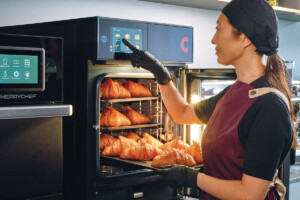
Staff training marks an important step in combi installation. Courtesy of Convotherm.
Labor. If employee turnover and/or skill level is a concern, smart offerings, including optical product recognition and recipe programming, are worth considering. These features typically cost extra, however. One maker suggests optic cooking can help take kitchen leaders off the line, instead shifting their focus to areas like inventory, ordering, training and development. Meanwhile, the feature takes the guesswork out of controls, adjusting for mixed product loads, heat and energy loss from opening the door, and more. “The oven doesn’t have bad days; only people do,” touted a chef demoing at the National Restaurant Association Show. One brand that has been using the Internet of Things and connected cooking for a decade takes oven communication beyond the kitchen in several ways. For example, an operator can call the manufacturer through the oven as well as control the oven from another room. “You can duplicate the operating system on your phone,” they explain. “With that small operator who’s doing a million things—they wear 100 hats and they’re off in another room—they can tell exactly what’s going on with that oven in the cooking process directly from their phone, and they can actually even control the oven from their phone.” A multiunit operator also can release cooking programs from headquarters, plus see combi data at large. With some smart programs, load size must be consistent, while others can intelligently adapt. User profiles, offered on at least one unit that launched this year, aid in customization. “Your executive chef could have all of the apps and features, where maybe a line cook doesn’t need all of that,” they note. This same unit also controls set humidity with a sensor (whereas some competitors use an algorithm) to help with cooking times, product quality and browning. No matter your choice, be sure you—and your staff—know your oven’s controls and capabilities to ensure consistency.
Efficiency. The Energy Star site lists over 240 certified models, most of which are electric, from more than 30 manufacturers. An electric combi is estimated to save $1,200 annually and $8,000 on utility bills over the product’s lifetime, while a gas model saves about $500 annually and $4,600 on lifetime utility bills, compared to standard combis. Of those we spoke with, at least two brands have added efficiencies to their steam generation processes, with one unit preheating incoming water to 195°F for on-demand steam. The other has a closed system which doesn’t exhaust steam, reducing energy and water use; in turn, its electric units also are ventless. Yet another brand offers users AI-informed consumption tips. Another maker says it is currently lab testing three more models for potential Energy Star certification.
Boiler-based or boilerless (aka spritzers). At least two manufacturers offer both types of combis, while others make just one. A boilerless maker we spoke to says boilers can be problematic as well as more expensive to repair, however, boilerless models can be sensitive to hardness in water. On the boiler-based side, one maker has a five-year warranty on the boiler, plus two years on parts and labor. It also says its recently introduced autonomous cleaning system option (more on this soon) helps descale the boiler to extend the unit’s life. No matter which format suits you best, size up manufacturers’ warranties and service relationships so you know what support you’re getting.
Shiny ‘N’ New
With any combi you choose, cleaning marks an important task, and several makers have worked to simplify the process.
At least two manufacturers removed the wash arm and moved to a recirculating cleaning system in which chemicals travel through the feed system, pipes and sprayers; they say this offers a deeper clean.
In addition, one company can serve any operator with a preference between solid or liquid cleaning chemicals. “A lot of operators preferred solid cleaning, regardless of the convenience of liquid,” they say. “But for a lot of customers, it was an either/or, so this year they came out with hybrid; it’s just a setting in the controls.”
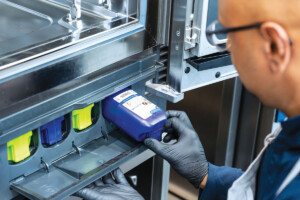
Several makers have made updates to their cleaning systems, simplifying the process. Courtesy of RATIONAL.
Several brands have solid-to-liquid cleaning canisters, one of which automatically doses the chemicals for both cleaning and descaling. “At the end of the day, it makes a recommendation on the screen to the operator what level cleaning should be done,” they explain. “They can also increase or decrease the amount of chemical, so they can really customize, or let the unit select the right amount of dose that is needed for the soil level.” With four slots, this maker says operators need not worry about running out of chemicals mid-cycle, whereas units with fewer slots may not finish if a cartridge runs out. The system, available as an add-on for tabletop units, also will record if a cartridge is replaced before it’s empty.
Further, one manufacturer says its use of corrosion-resistant 316L stainless in the cavity and all metal internal parts aids in cleanliness. “We have an upper limit of chlorides that is three times higher than anyone else in the industry, and that has literally almost completely removed the need for reverse osmosis systems in our combi ovens,” they say.
Plug It In
Once you have a better idea of the features and specs you want, a test run is recommended. Online showcases, in-person demos and even a 30-day test-to-buy program mark a few ways you can see select combis in action.
Two Strong
At The NAFEM Show 2025, one traditional combi maker launched a hybrid unit combining steam, convection cooking and microwave technology. This is the second such unit to hit the market, with another maker’s launching in 2023.
The newest unit offers microwave power across all six shelves, and automated cleaning comes standard. “It was something that we developed for over 10 years to figure out how to intelligently add the right amount of microwave power to the combi,” they say, noting that it’s an ideal solution for operations like stadiums that need high-speed service.
These hybrid units, however, are ineligible for Energy Star certification.
Checking It Twice
Go through the following paces for good measure:
1. Do a preliminary site survey. Some manufacturers have customers fill one out before a purchase order to help ensure water quality, space and power meet unit requirements. Doing so helps catch any dealbreakers, such as a drain under the combi or improper water or gas pressure.
2. Check the doors. Doors are not field reversible, and makers have seen preferences get lost along the way. Review your final order to be sure.
3. Mind your controller. If your controller is on the side, avoid placing high-heat equipment next to it or, at the least, add a heat shield to protect electronics.
4. Have the unit properly installed. Leave installation to designated professionals, or you might find your warranty coverage—and your cooking performance —altered.
5. Train your staff. Particularly if you have smart cooking features where you didn’t before, top-to-bottom training ensures all know how to care for and take advantage of a unit’s unique capabilities. To aid operators in getting up and running, one maker added a QR sticker to all its units this year; once scanned, you will find all the videos you need to get going; it also has a training app. Another offers a free half-day chef consultation.
Picture This
Consider which maker’s user-friendly combi and/or combi accessory
best fit your needs.
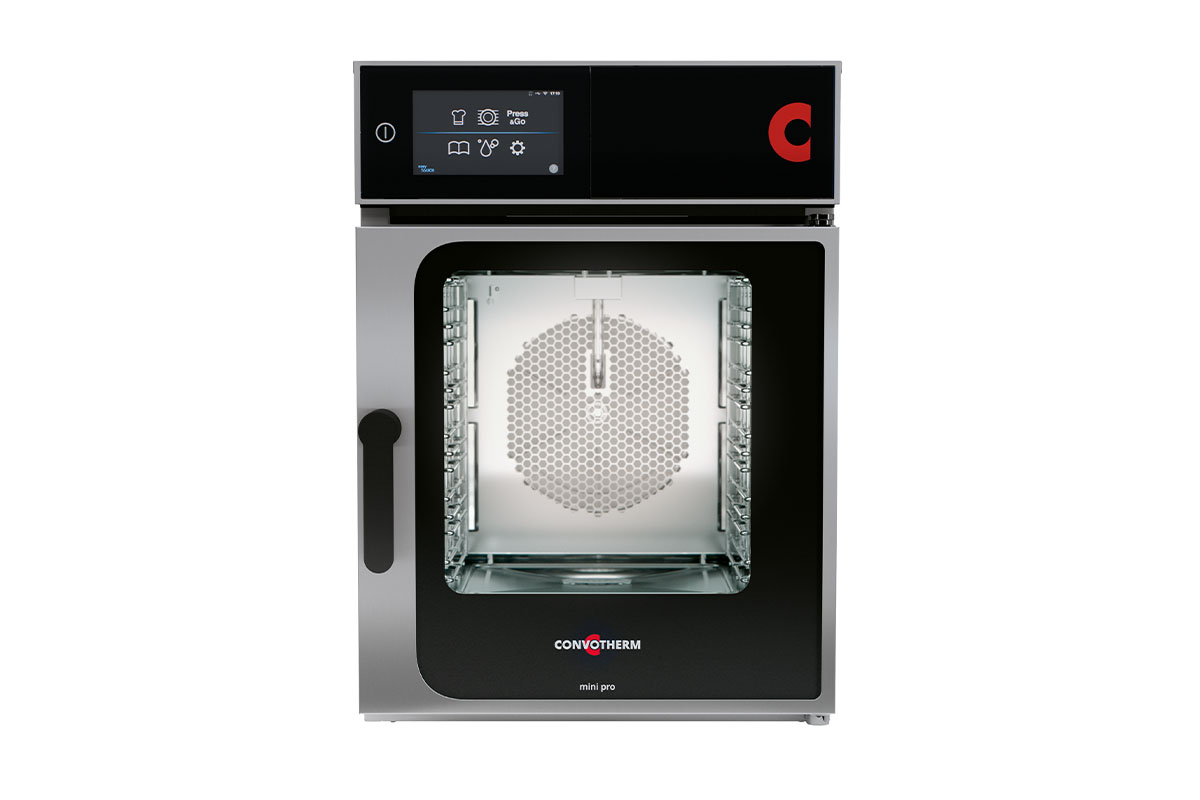
Convotherm
Model: Mini Pro (6.10 pictured)
Features: This ventless compact combi’s optional AI-powered optical cooking helps operators save labor, energy and food waste. Keep clean with solid-to-liquid cleaning cartridges, which deliver 30 cycles per cartridge. Integrate with KitchenConnect for menu management and more. Choose from three sizes, stainless or black finishes, and single or stacked setups (with no kit required).
Website: convotherm.com
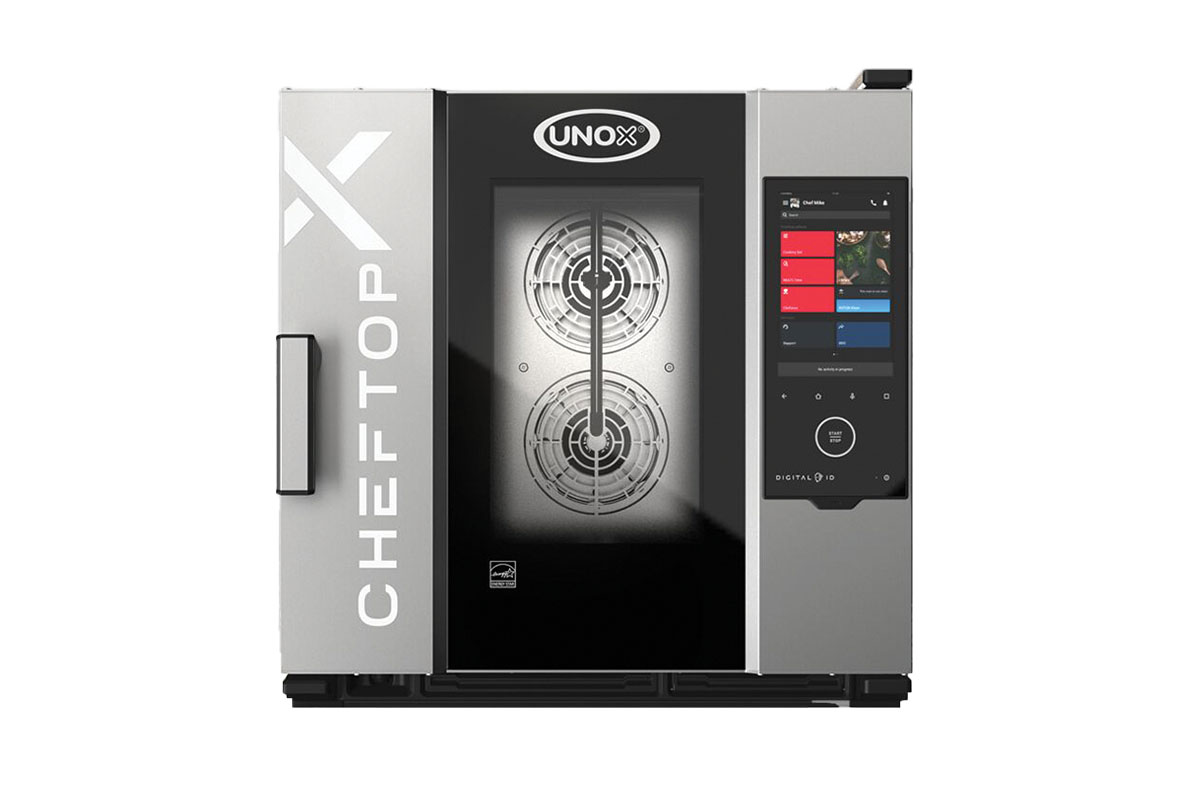
Unox
Model: Cheftop-X
Features: With options for voice control capabilities, remote monitoring, self-cleaning and more, this model is touted as the brand’s “most advanced combi oven to date.” An optic cooking add-on recognizes product and activates the proper cooking program. The oven also monitors and adjusts energy consumption, plus offers personalized efficiency recommendations.
Website: unox.com
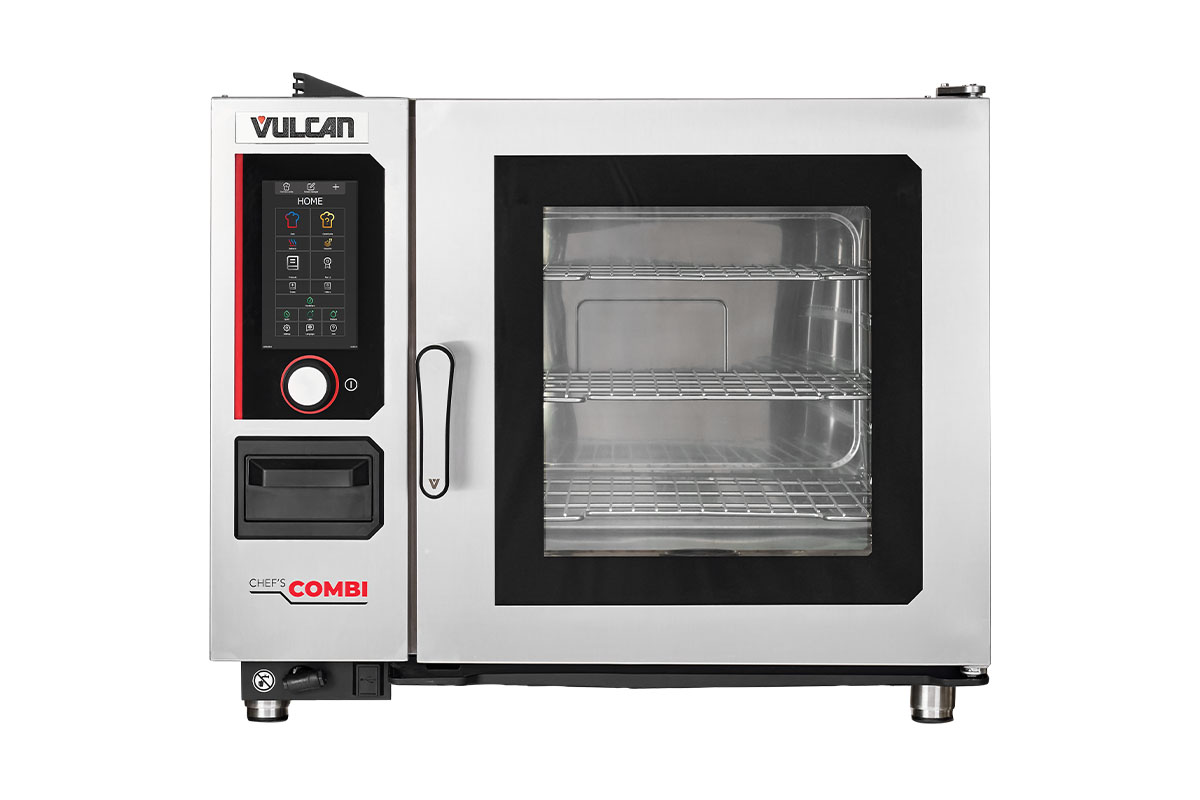
Vulcan
Model: Chef’sCombi
Features: Customize the touch screen to show or hide select cooking assistance features and more, adapting to individual preferences. Automatic soil detection, paired with solid tablet-based cavity cleaning and descaling sticks, ease maintenance plus cut water and chemical costs. Choose from six- or 10-level half-size or full-size units, plus gas or electric options.
Website: vulcanequipment.com
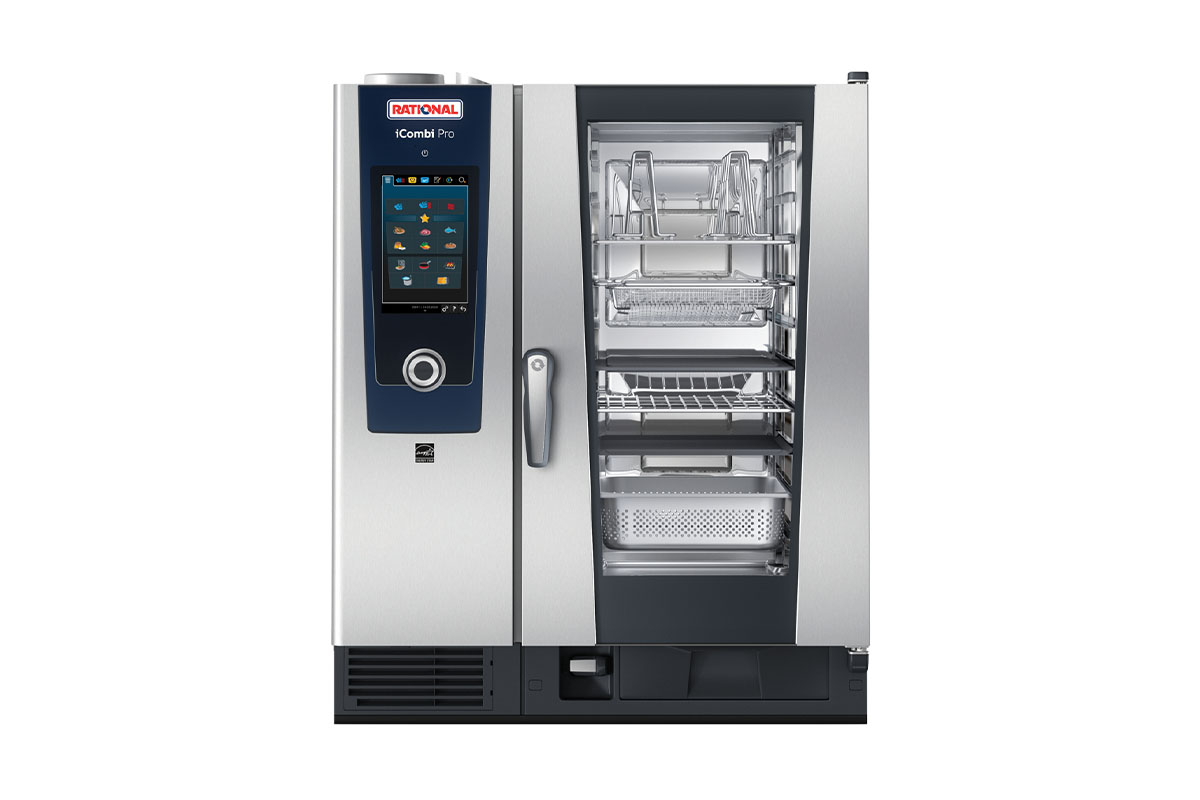
RATIONAL
Model: iCareSystem AutoDose
Features: This autonomous cleaning system, available on iCombi Pro tabletop units (like the iCombi Pro 10; pictured above), doses chemicals, drawing from up to four cartridge slots. Schedule or activate a cycle on the unit’s screen, and/or receive alerts when cleaning is due. The latest addition rounds out features like the production manager, which helps with sequencing, and sensor-powered cooking programs.
Website: rational-online.com
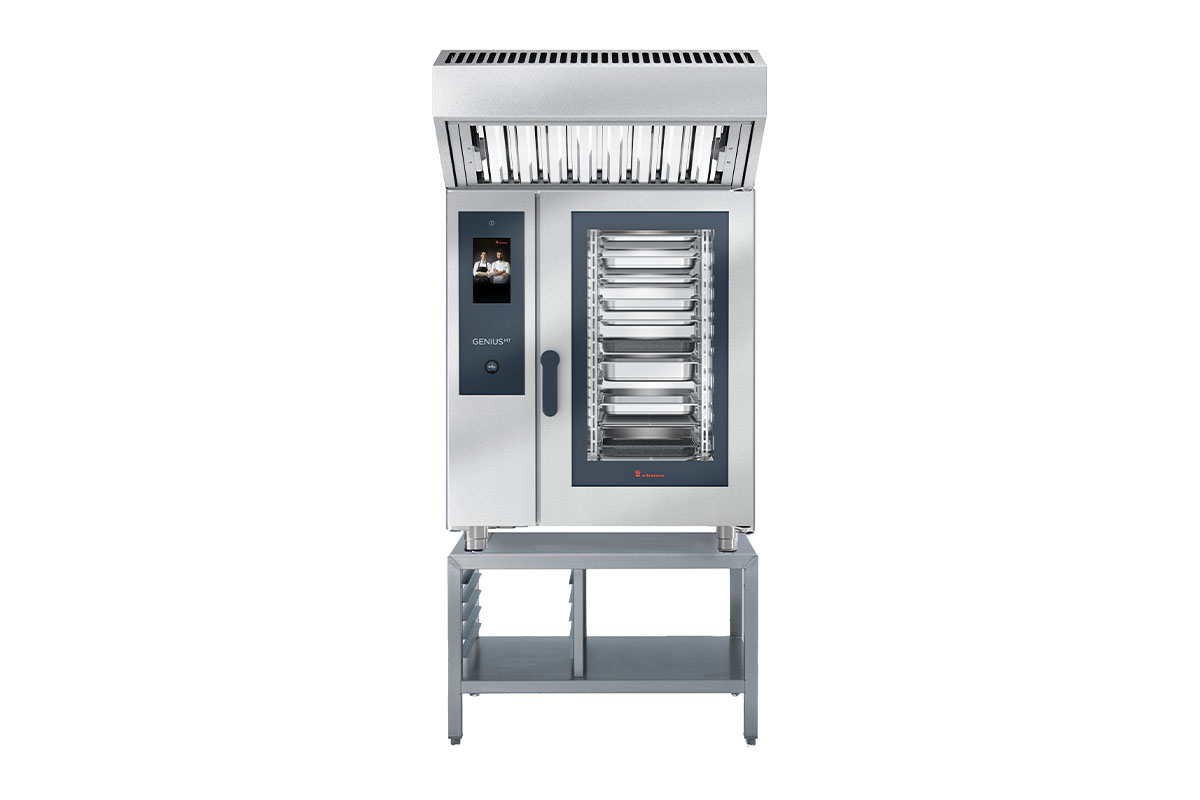
Eloma
Model: Genius MT
Features: Curate your favorite recipes, with room for 1,000 programs. Use liquid or solid cleaning chemicals due to a hybrid cleaning system. An eco steam setting uses 33% less water than a prior model’s steam function. A ventless option (pictured) marks one of the latest
add-ons for the line, which has electric and gas models.
Website: eloma.com
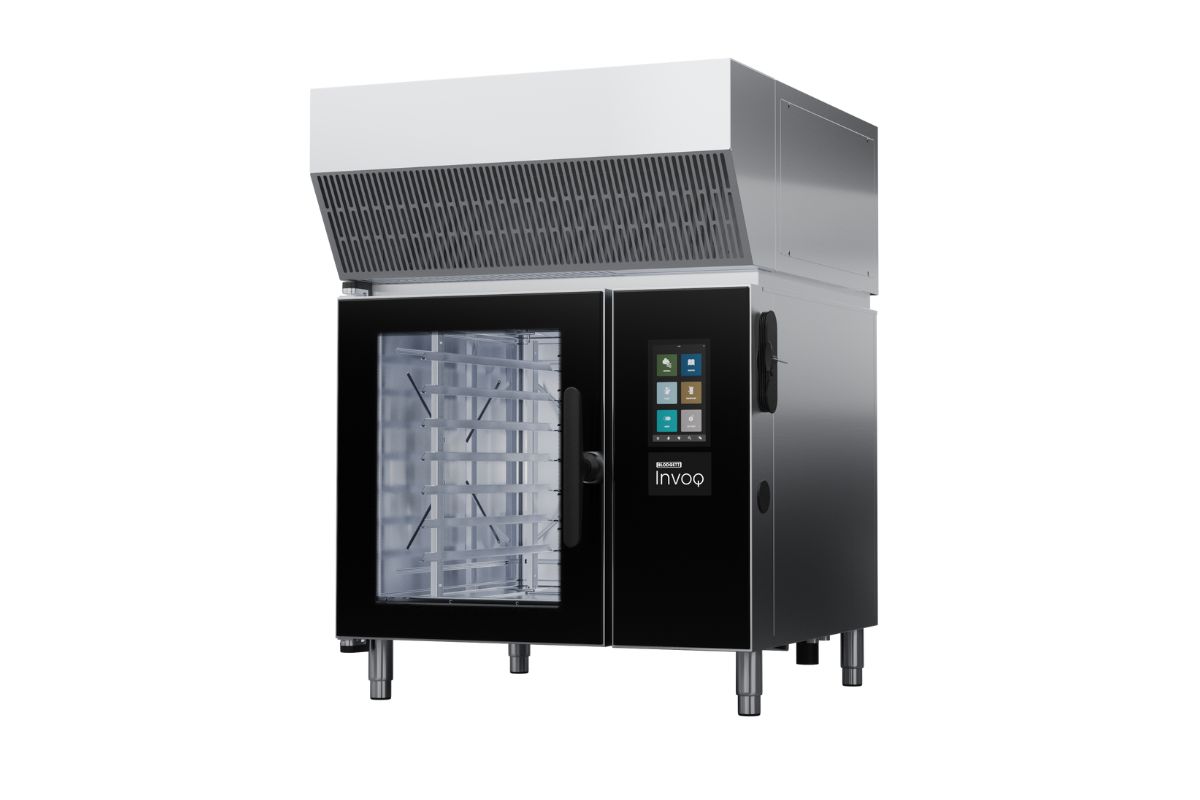
Blodgett
Model: Invoq Hoodini
Features: The recent addition of this integrated hood enables ventless operation for added locational flexibility and convenience on select electric models. No filter changes or filter cleanings are needed. A 120 V single-phase plug must be within 10 feet.
Website: blodgett.com
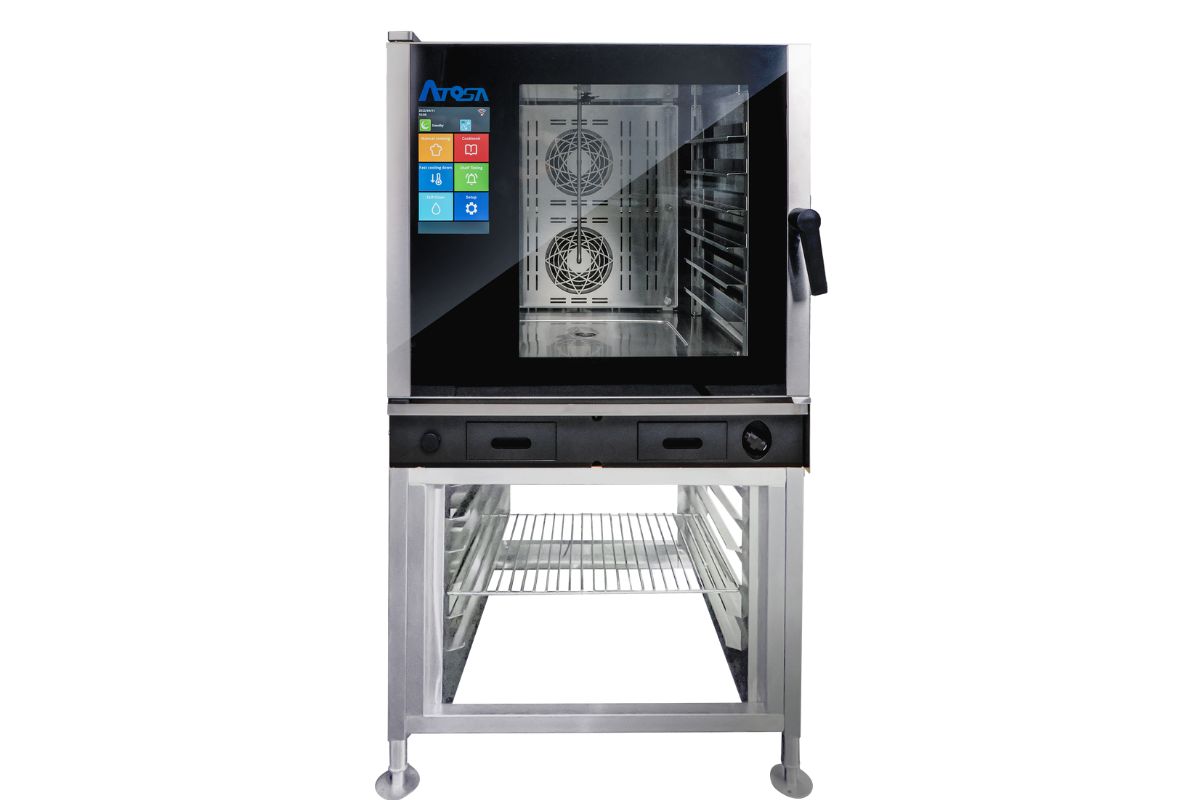
Atosa
Model: Smart Touch Combi
Features: Monitoring of cooking temperatures and humidity are automated, and the unit detects soil and usage for right-sized automatic cleaning. Choose from five Energy Star rated models, with capacities between five and 20 12 x 20 pans. Wi-Fi features are expected to debut soon.
Website: atosausa.com

Lainox
Model: Naboo 5.0
Features: A free virtual kitchen assistant, accessible through built-in Wi-Fi connectivity , offers advice on cooking, cleaning, maintenance and more. A new washing system reduces detergent consumption by about 30%. A boosted preheating option (up to 608°F) helps to reduce cook times when the oven is full.
Website: lainox.it
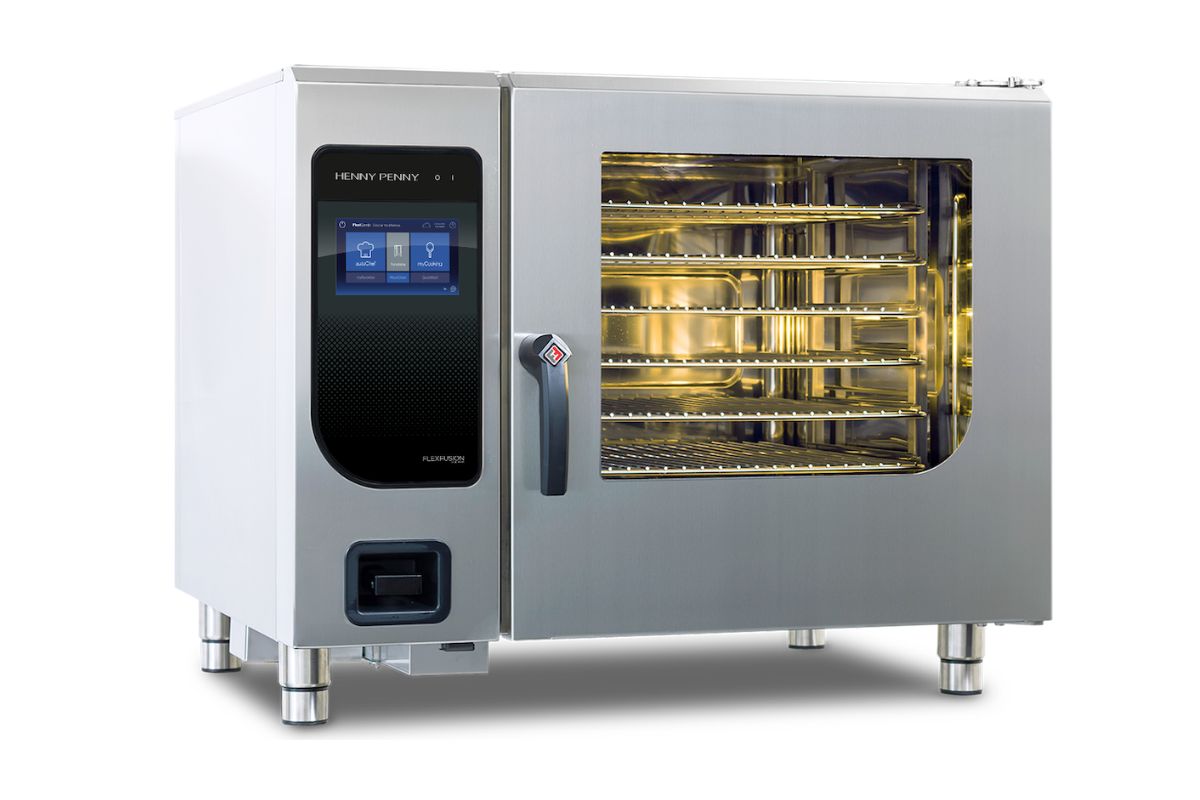
Henny Penny
Model: FlexFusion FPE 615
Features: This Energy Star certified electric unit has an improved heat exchange design to save energy and water. A smartphone-like touch screen adds ease of use. Create recipes with up to 20 steps or peruse 350 included programs. An updated cleaning program uses 36% less water than before.
Website: hennypenny.com
Editor’s note: All featured models/accessories have been released or updated since September 2023.
RELATED CONTENT
- Advertisement -
- Advertisement -
- Advertisement -
TRENDING NOW
- Advertisement -
- Advertisement -
- Advertisement -

